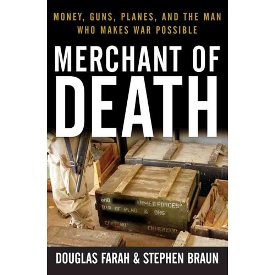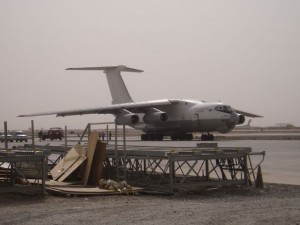
If you’ve served with the Canadian Forces in Africa, the Balkans, or the Middle East, chances are you’ve flown through airfields and seen numerous white former Soviet Air Force Ilyushin 76 transport aircraft, on the ramp loading, taking off, or landing. Chances are there were weapons, helicopters and equipment aboard those aircraft categorized as “spare parts.” Chances are you saw aircraft belonging to Victor Bout, the Milo Minderbinder of our generation. And, like that memorable Catch-22 character “Victor B” is adept at profiting from two or more antagonists more or less simultaneously, to stunning effect.
Farah and Braun have assembled a fascinating account of Victor Bout (pronounced ‘Boot’) and his shadowy activities based on interviews with intelligence and diplomatic personnel and from the records of observers obsessed with the coming and goings of Air Cess, Air Bas, Flying Dolphin, Transavia, and a myriad of other front companies and their connections.
Victor Bout, a former alleged GRU agent, branched out after the collapse of the Soviet Union. Building on Cold War contacts established by the Soviets in the 1970s and 1980s to supply arms to the so-called “National Liberation Movements” in the Third World, Bout and company(ies) essentially privatized the system to profit from keeping the former Soviet allies in guns and ammo-with tidy profits reaped in the form of diamonds, gems, and cold hard cash. One of the more astounding parts of the book describes Bout’s involvement in encouraging and then supporting a rebel movement seize a diamond-rich area in Africa so other partners could extract the minerals without interference.
Canadian observers of the Afghanistan scene will be intrigued with Farah and Braun’s account of how Victor Bout supported the forces of Ahmad Shah Massoud, Rashid Dostum, and the Taliban, all at the same time. It is evident that Bout’s Ilyushins and Antonovs were delivering ammunition and weapons to the factions and exporting opium on the return trips. Bout’s support to Al Qaeda in the pre-9/11 days is equally interesting as is the discussion of how the Taliban used Ariana airlines for their covert purposes-with Bout’s assistance. Did Bin Laden escape on a Victor Bout-controlled aircraft? Indeed, the link between Albanian weapons stores and the war in Afghanistan will be new to most readers.
The most disturbing portions of the book deal with the use of Bout aircraft to deliver massive quantities of weapons to extremely violent factions in Sierra Leone, Liberia, Zaire/Congo and as is alleged, Rwanda. The general public forgets that the Soviet-designed and exported AK-47 assault rifle and subsequent designs are responsible for far more deaths in the Third World that the dead of Hiroshima and Nagasaki combined. Merchant of Death explains how Bout and his people provided an uninterrupted pipeline of Kalashnikovs and ammunition from former Soviet bloc countries to whoever could pay throughout Africa.
The paradox of a man like Bout is that he controls a majority of what are fewer and fewer commercial heavy lift aircraft, making him and his companies valuable resources for countries that wanted to save money and bought into Alternative Source Delivery military logistics systems in the 1990s. Was the moral cost worth not spending money on nationally-controlled fleets of heavy lift transports and then resorting to men like Bout? What price sovereignty?
Farah and Braun have provided us with a window into a world that otherwise remains opaque because it needs to and a man who appears to be a late 20th Century reincarnation of Basil Zaharoff. Despite its cliché’d title, Merchant of Death is well worth reading-and thinking about.

Hmmmm….one of Viktor’s fleet or not?
This review Originally Appeared in Canadian Army Journal.